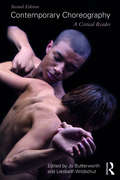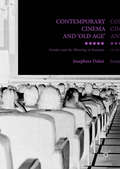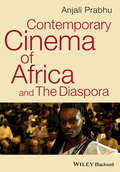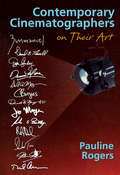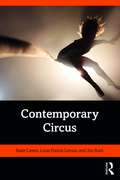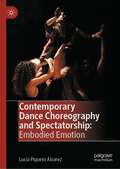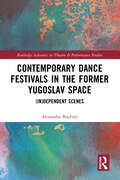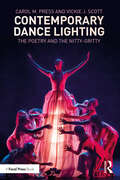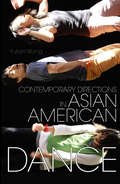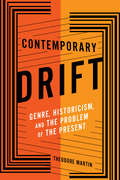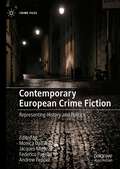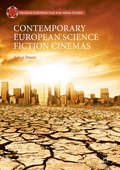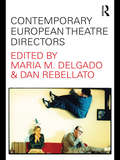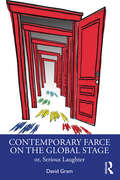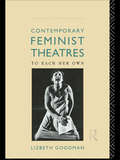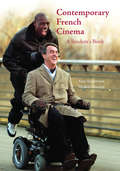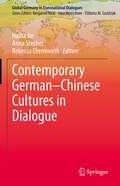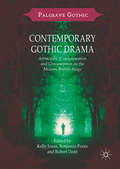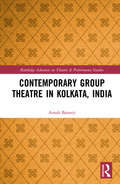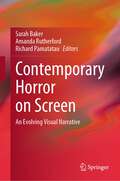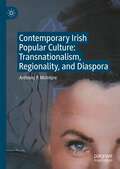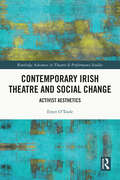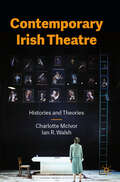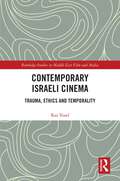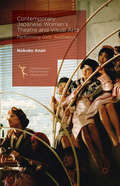- Table View
- List View
Contemporary Choreography: A Critical Reader
by Jo Butterworth Liesbeth WildschutFully revised and updated, this second edition of Contemporary Choreography presents a range of articles covering choreographic enquiry, investigation into the creative process, and innovative challenges to traditional understandings of dance making. Contributions from a global range of practitioners and researchers address a spectrum of concerns in the field, organized into seven broad domains: Conceptual and philosophical concerns Processes of making Dance dramaturgy: structures, relationships, contexts Choreographic environments Cultural and intercultural contexts Challenging aesthetics Choreographic relationships with technology. Including 23 new chapters and 10 updated ones, Contemporary Choreography captures the essence and progress of choreography in the twenty-first century, supporting and encouraging rigorous thinking and research for future generations of dance practitioners and scholars.
Contemporary Cinema and 'Old Age': Gender and the Silvering of Stardom
by Josephine DolanThis book is the first to explore ‘old age’ in cinema at the intersection of gender, ageing, celebrity and genre studies. It takes its cue from the dual meanings of ‘silvering’ – economics and ageing – and explores shifting formulations of ‘old age’ and gender in contemporary cinema. Broad in its scope, the book establishes the importance of silver audiences to the survival of cinema exhibition while also forging connections between the pleasures of ‘old age’ films, consumer culture, the ‘economy of celebrity’ and the gendered silvering of stardom. The chapters examine gendered genres such as romantic comedies, action and heist movies, the prosthetics of costume, and CGI enabled age transformations. Through this analysis, Josephine Dolan teases out the different meanings of ageing masculinity and femininity offered in contemporary cinema. She identifies ageing femininity as the pathologised target of rejuvenation while masculine ageing is seen to enhance an enduring youthfulness. This book has interdisciplinary appeal and will engage scholars interested in ‘old age’ and gender representations in contemporary cinema.
Contemporary Cinema of Africa and the Diaspora
by Anjali PrabhuAnalyzing art house films from the African continent and the African diaspora, this book showcases a new generation of auteurs with African origins from political, aesthetic, and spectatorship perspectives. Focuses on art house cinema and discusses commercial African cinema Enlarges our understanding of African film to include thematic and aesthetic influence Highlights aesthetic and political aspects including racial identity, women’s issues, and diaspora Heavily illustrated with over 90 film stills Features selected stills integral to the filmic analysis in full color Moves beyond Western-oriented analytical paradigms
Contemporary Cinematographers on Their Art
by Pauline B RogersThe twelve interviews in this book cover all aspects of cinematography from pre-production planning to post-production, special effects, aerial photography, and second unit. Each interview gives a behind-the-scenes look at how some of the most popular shots in movies and television shows were lit and captured. Technically and philosophically oriented, Contemporary Cinematographers on Their Art explores the tools, trends, personalities, and professional achievements of contemporary cinematographers, highlighting the behind-the-scenes struggles of the business of making motion pictures. Each chapter delves into the personal challenges, political properties, inter-departmental interactions, and artistic achievements of the artists who bring scripts to life through their choice of cameras, lights, lenses, filters, gels, and other supporting equipment.Covering a variety of film and television genres--from soaps to half-hour sitcoms, to cable and network productions and low- and big-budget features--each interview explores the tools cinematographers use to capture their shots, from traditional equipment to innovative camera and lighting "toys," as well as the integration of mechanical and computer graphic effects.
Contemporary Circus: Conversations With Creators
by Katie Lavers Louis Patrick Leroux Jon BurttIn this volume, twenty-four creators come together with three scholars to discuss Contemporary Circus, bridging the divide between practice and theory. Lavers, Leroux, and Burtt offer conversations across four key themes: Apparatus, Politics, Performers, and New Work. Extensively illustrated with fifty photos of Contemporary Circus productions, and extensively annotated, Contemporary Circus thematically groups and contextualises extracts of conversations to provide a sophisticated and wide-ranging study supported by critical theory. Of interest to both practitioners and scholars, Contemporary Circus uses the lens of ‘contestation,’ or calling things into question, to provide a portal into ways of seeing today’s circus performance. Conversations with: Lachlan Binns and Jascha Boyce (Gravity and Other Myths), Tilde Björfors (Cirkus Cirkör), Kim ‘Busty Beatz’ Bowers (Hot Brown Honey), Shana Carroll (The 7 Fingers), David Clarkson (Stalker), Philippe Decouflé (Compagnie DCA), Fez Faanana (Briefs), Mike Finch (Circus Oz), Daniele Finzi Pasca (Compagnia Finzi Pasca), Sean Gandini (Gandini Juggling), Firenza Guidi (ElanFrantoio, NoFit State Circus), Jo Lancaster and Simon Yates (Acrobat), Johann Le Guillerm (Cirque Ici), Yaron Lifschitz (Circa), Chelsea McGuffin (Company 2), Phia Ménard (Compagnie Non Nova), Jennifer Miller (Circus Amok), Adrien Mondot (Compagnie Adrien M and Claire B), Charlotte Mooney and Tina Koch (Ockham’s Razor), Philippe Petit (high wire artist), and Elizabeth Streb (STREB EXTREME ACTION).
Contemporary Dance Choreography and Spectatorship: Embodied Emotion
by Lucía Piquero ÁlvarezThis book offers an approach which unites choreographic and spectatorial perspectives, and argues for dance itself—its materials, its structures—as a medium of emotional communication. Contemporary dance often seems to contend with issues of understanding, regularly being “read” in “languages” which alienate it. Even if emotion seems a significant part of people’s engagement with dance, its workings are often surrounded by an air of mysticism. Engaging with these issues, this study investigates the experience of emotion in Euro-American contemporary dance theatre. It questions its dependence on the artist’s personal emotions, and the assumption that it is mediated by representational meaning. Instead, this book proposes that the emotional import of dance emerges from an interplay between perceptual properties and symbolic elements in an embodied affective cognitive experience. This experience includes the background of the spectator as well as the context of work, choreographer, performer(s) and other creative agents.
Contemporary Dance Festivals in the Former Yugoslav Space: (in)dependent Scenes (Routledge Advances in Theatre & Performance Studies)
by Alexandra BaybuttThis book expands the understanding of conditions defining the creation and circulation of contemporary dance that differ across Europe. It focuses on festival-making connected with the Balkan regional project ‘Nomad Dance Academy’ (NDA), and highlights collective approaches to sustain a theorisation of festivals using the concepts of dissensus and imperceptible politics. Drawing from anthropological methods, three festivals PLESkavica, Slovenia; Kondenz, Serbia and LocoMotion, North Macedonia, are explored through social, political and historical currents affecting curatorial practice. This book closely follows how festival-makers navigate the values of international development that during and after the Yugoslav wars looked to art as part of peacekeeping and nation-building processes. This coincided with increasing discourse and practices of contemporary dance that gained momentum in the 1980s alongside European festivalisation. I show how contemporary dance acts as an agent for transformation, but also a carrier of older forms of social organisation, reflecting methods and values of Yugoslav Worker Self-management that are deployed by the groups creating the festivals. This book will be of interest to dance scholars as well as researchers tracing the long-term effects of the dissolution of the Socialist Federal Republic of Yugoslavia.
Contemporary Dance Lighting: The Poetry and the Nitty-Gritty
by Carol M. Press Vickie J. ScottContemporary Dance Lighting: The Poetry and the Nitty-Gritty dynamically guides students toward aesthetically, creatively, and skillfully becoming lighting designers for dance in the 21st century. The book is organized in three parts, covering everything from the aesthetic considerations of lighting for dance to the tools and technology designers use to create compelling artistry. Part I, "Beginnings" establishes context, explaining the structure of the book and illuminating the history of contemporary dance and lighting. Part II, "The Poetry" elaborates on the key artistic and aesthetic elements of contemporary dance lighting: visual narrative; controllable functions and qualities of light; use of space, color, and time; importance and intricacies of collaboration; and continual effects and evolution of technology. Part III, "The Nitty-Gritty" steers students through the technical knowledge and skills necessary to design lighting, including understanding your tools and positioning instruments; creating layered light plots; organizing extensive paperwork; and archiving. The dance Artifice, choreographed by Jerry Pearson, is sequentially explored throughout the book to convey key concepts. "Further Reflections" conclude each chapter, written by a diverse group of renowned professionals, inviting young designers directly into the world of lighting design. This textbook is for use in Lighting Design and Design for Dance Lighting courses at the university level, along with professional training programs.
Contemporary Directions in Asian American Dance (Studies in Dance History)
by Yutian WongThe definition of Asian American dance is as contested as the definition of "Asian American." The contributors to this volume address such topics as the role of the 1960s Asian American movement in creating Japanese American taiko groups, and the experience of internment during World War II influencing butoh dance in Canada. Essays about artists such as Jay Hirabayashi, Alvin Tolentino, Shen Wei, Kun-Yang Lin, Yasuko Yokoshi, Eiko & Koma, Sam Kim, Roko Kawai, and Denise Uyehara look closely at the politics of how Asian aesthetics are set into motion and marketed. The volume includes first-person narratives, interviews, ethnography, cultural studies, performance studies, and comparative ethnic studies.
Contemporary Drift: Genre, Historicism, and the Problem of the Present (Literature Now)
by Theodore MartinWhat does it mean to call something “contemporary”? More than simply denoting what’s new, it speaks to how we come to know the present we’re living in and how we develop a shared story about it. The story of trying to understand the present is an integral, yet often unnoticed, part of the literature and film of our moment. In Contemporary Drift, Theodore Martin argues that the contemporary is not just a historical period but also a conceptual problem, and he claims that contemporary genre fiction offers a much-needed resource for resolving that problem.Contemporary Drift combines a theoretical focus on the challenge of conceptualizing the present with a historical account of contemporary literature and film. Emphasizing both the difficulty and the necessity of historicizing the contemporary, the book explores how recent works of fiction depict life in an age of global capitalism, postindustrialism, and climate change. Through new histories of the novel of manners, film noir, the Western, detective fiction, and the postapocalyptic novel, Martin shows how the problem of the contemporary preoccupies a wide range of novelists and filmmakers, including Zadie Smith, Colson Whitehead, Vikram Chandra, China Miéville, Kelly Reichardt, and the Coen brothers. Martin argues that genre provides these artists with a formal strategy for understanding both the content and the concept of the contemporary. Genre writing, with its mix of old and new, brings to light the complicated process by which we make sense of our present and determine what belongs to our time.
Contemporary European Crime Fiction: Representing History and Politics (Crime Files)
by Andrew Pepper Federico Pagello Monica Dall’Asta Jacques MigozziThis book represents the first extended consideration of contemporary crime fiction as a European phenomenon. Understanding crime fiction in its broadest sense, as a transmedia practice, and offering unique insights into this practice in specific European countries and as a genuinely transcontinental endeavour, this book argues that the distinctiveness of the form can be found in its related historical and political inquiries. It asks how the genre’s excavation of Europe’s history of violence and protest in the twentieth century is informed by contemporary political questions. It also considers how the genre’s progressive reimagining of new identities forged at the crossroads of ethnicity, gender, and sexuality is offset by its bleaker assessment of the corrosive effects of entrenched social inequalities, political corruption, and state violence. The result is a rich, vibrant collection that shows how crime fiction can help us better understand the complex relationship between Europe’s past, present, and future. Seven chapters are available open access under a Creative Commons Attribution 4.0 International License via link.springer.com.
Contemporary European Science Fiction Cinemas (Palgrave European Film and Media Studies)
by Aidan PowerContemporary European Science Fiction Cinemas charts the evolution of European science fiction cinema in the 21st century, a period in which Europe itself has faced myriad crises. Key to this study is an exploration of how European science fiction responds to prevalent issues such as the financial crisis, political extremism and violence, large-scale migration and indeed the potential breakup of the European Union itself. What futures does science fiction cinema envision for Europe? Is it capable of moving beyond dystopian visions of a continent beset by seemingly omnipresent turbulence? Emphasising science fiction’s unique ability to estrange, exploit and reflect upon popular concerns, this book directly engages with such questions, accounting for ongoing mutations in the very nature of the European project as it does so.
Contemporary European Theatre Directors
by Maria M. Delgado Dan Rebellato'An invaluable book that we shall all be using for a long time to come' - Michael Billington Contemporary European Theatre Directors is an ambitious and unprecedented overview of many of the key directors working in European theatre over the past fifty years. It is a vivid account of the vast range of work undertaken in European theatre during this period, situated lucidly in its artistic, cultural and political context. The resulting study is a detailed guide to the generation of directors whose careers were forged and tempered in the changing Europe of the 1980s and 1990s. The featured directors are:Calixto Bieito, Piotr Borowski, Romeo Castellucci, Frank Castorf, Patrice Chéreau, Lev Dodin, Declan Donnellan, Kristian Frédric, Rodrigo García, Jan Lauwers, Christoph Marthaler, Simon McBurney, Daniel Mesguich, Katie Mitchell, Ariane Mnouchkine, Thomas Ostermeier, Patrice Pavis, Silviu Purc?rete and Peter Sellars. Travelling from London and Craiova to St. Petersburg and Madrid, the book examines directors working with classics, new writing, and new collaborative theatre forms. Each chapter is written by a specialist in European theatre and provides a detail critique of production styles. The directors themselves provide contributions and interviews to this multi-authored work, which unites the many and varied voices of European theatre in one coherent volume.
Contemporary Farce on the Global Stage: or, Serious Laughter
by David GramContemporary Farce on the Global Stage provides audiences and practitioners a detailed survey of how the genre of farce has evolved in the 21st century. Often dismissed as frivolous, farce speaks a universal language, with the power to incisively interrogate our world through laughter.Unlike farces of the past, where a successful resolution was a given and we could laugh uproariously at adulterous behaviour, farce no longer guarantees an audience a happy ending where everything works out. Contemporary farce is no longer ‘diverting us’ with laughter. It is reflecting the fractured world around us. With a foreword by award-winning playwright Ken Ludwig, the book introduces readers to the Mechanics of Farce, and the ‘Four Ps,’ which are key elements for understanding, appreciating, and exploring the form. The Five Doors to Contemporary Farce identify five major categories into which farces fall. Behind each door are a wide selection of plays, modern and contemporary examples from all over the world, written by a diverse group of playwrights who traverse gender, race, ethnicity, and sexual orientation. Supplementing each section are comments, observations, and reflections from award-winning playwrights, directors, actors, designers, dramaturgs, and scholars.Designed specifically to give theatre-makers a rounded understanding that will underpin their own productions, this book will also be of use to theatre and performance studies students.
Contemporary Feminist Theatres: To Each Her Own (Gender in Performance)
by Lizbeth GoodmanContemporary Feminist Theatres is a major evaluation of the forms feminism has taken in the theatre since 1968. Lizbeth Goodman provides a provocative and interdisciplinary study of the development of feminist theatres in Britain. She examines the treatment of key issues such as gender, race, sexuality, language and power in performance. Based on original research and fresh data, Contemporary Feminst Theatres is a fully comprehensive and admirably clear analysis of a flourishing field of practice and inquiry.
Contemporary French Cinema: A Student's Book
by Alan J. Singerman Michèle BissièreLike its French-language companion volume Le Cinéma français contemporain: Manuel de classe, Alan Singerman and Michèle Bissière's Contemporary French Cinema: A Student's Book offers a detailed look at recent French cinema through its analyses of twenty notable and representative French films that have appeared since 1980. Sure to delight Anglophone fans of French film, it can be used with equal success in English-language courses and, when paired with its companion volume, dual-language ones.Acclaim for Le Cinéma français contemporain: Manuel de classe "From Le Dernier Métro to Intouchables, Bissière and Singerman cover the latest trends of French cinema, emphasizing context and analytical method as Singerman did in Apprentissage du cinéma français (Focus 2004). The authors offer a selection of films most French cinephiles will applaud, and they incorporate insights from some of the best critical work on French cinema. Students of French film will also find all the bibliographical pointers they need to dig deeper, and instructors will appreciate the pedagogical components included in the chapters." —Jonathan Walsh, Department of French Studies, Wheaton College, Massachusetts "This remarkable book comes to us from two seasoned teachers and critics and beautifully complements an earlier work, Alan Singerman's Apprentissage du cinéma français. The time period covered, more targeted here than in the preceding text, is admirably well chosen, and the breakdown by broad category, each offering multiple options, guides the teacher while offering a choice among an abundance of interesting films. The preliminary chapters, both succinct and informative, give students an excellent overview of French cinema as a whole and of the technical knowledge needed for film analysis. Each of the subsequent chapters offers an indispensable introduction discussing the plot, director, production, actors, reception, and context of the film in question and also provides a very useful filmography and bibliography… an exemplary work." —Brigitte E. Humbert, Department of French and Francophone Studies, Middlebury College
Contemporary German–Chinese Cultures in Dialogue (Global Germany in Transnational Dialogues)
by Haina Jin Anna Stecher Rebecca EhrenwirthThis book provides a unique perspective on contemporary German and Chinese cultural encounters. Moving away from highlighting exchanges between the two countries in terms of colonial connections, religious influences and philosophical impacts, the book instead focuses on the vast array of modern cultural dialogues that have influenced both countries, especially in literature, theatre and film. The book discusses issues of translation, adaptation, and reception to reveal a unique cultural relationship. The editors and contributors examine the existing programs and strategies for cultural interchange, and analyse how these shape or have shaped intercultural dialogue, and what kind of intercultural exchange is encouraged. This book is of interest to students and researchers of film and media studies, Sinophone studies, transnational studies, cultural studies and social and cultural anthropology.
Contemporary Gothic Drama: Attraction, Consummation and Consumption on the Modern British Stage (Palgrave Gothic)
by Kelly Jones Robert Dean Benjamin PooreThis ground-breaking volume is the first of its kind to examine the extraordinary prevalence and appeal of the Gothic in contemporary British theatre and performance. Chapters range from considerations of the Gothic in musical theatre and literary adaptation, to explorations of the Gothic’s power to haunt contemporary playwriting, macabre tourism and site-specific performance. By taking familiar Gothic motifs, such as the Gothic body, the monster and Gothic theatricality, and bringing them to a new contemporary stage, this collection provides a fresh and comprehensive take on a popular genre. Whilst the focus of the collection falls upon Gothic drama, the contents of the book will embrace an interdisciplinary appeal to scholars and students in the fields of theatre studies, literature studies, tourism studies, adaptation studies, cultural studies, and history.
Contemporary Group Theatre in Kolkata, India (Routledge Advances in Theatre & Performance Studies)
by Arnab BanerjiThis book is the first of its kind offering a materialistic semiotic analysis of a non-Western theatre culture: Bengali group theatre. Arnab Banerji fills two lacunas in contemporary theatre scholarship. First, the materialist semiotic approach to studying a non-Western theatre event allows Banerji to critically examine the material conditions in which theatre is created and seen outside the Euro-American context. And second, by shifting the critical lens onto a contemporary urban theatre phenomenon from India, the book attempts to even out the scholastic imbalance in Indian theatre scholarship which has largely focused on folk and classical traditions. The book shows a refreshing new perspective toward a theatre culture that frequently escapes the critical lens in spite of being one of the largest urban theatre cultures in the world. Theatre events are a sum total of the conditions in which they are built and the conditions in which they are viewed. Studying the event separate from its materialistic beginnings and semiotic effects allow only a partial insight into the performance phenomenon. The materialist semiotic critical framework of this book locates the Bengali group theatre within its performative context and offers a heretofore unexplored insight into this vibrant theatre culture.
Contemporary Horror on Screen: An Evolving Visual Narrative
by Amanda Rutherford Sarah Baker Richard PamatatauThis book highlights how horror in film and television creates platforms to address distinct areas of modern-day concern. In examining the prevalence of dark tropes in contemporary horror films such as Get Out, Annabelle: Creation, A Quiet Place, Hereditary and The Nun, as well as series such as Stranger Things, American Horror Story and Game of Thrones, amongst numerous others, the authors contend that we are witnessing the emergence of a ‘horror renaissance’. They posit that horror films or programmes, once widely considered to be a low form of popular culture entertainment, can contain deeper meanings or subtext and are increasingly covering serious subject matter. This book thus explores how horror is utilised as a tool to explore social and political anxieties of the cultural moment and is thus presented as a site for contestation, exploration and expansion to discuss present-day fears. It demonstrates how contemporary horror reflects the horror of modern-day life, be it political, biological, social or environmental. A vital contribution to studies of the horror genre in contemporary culture, and the effect it has on social anxieties in a threatening and seemingly apocalyptic time for the world, this is a vital text for students and researchers in popular culture, film, television and media studies.
Contemporary Irish Popular Culture: Transnationalism, Regionality, and Diaspora
by Anthony P. McIntyreThis book uses popular culture to highlight the intersections and interplay between ideologies, technological advancement and mobilities as they shape contemporary Irish identities. Marshalling case studies drawn from a wide spectrum of popular culture, including the mediated construction of prominent sporting figures, Troubles-set sitcom Derry Girls, and poignant drama feature Philomena, Anthony P. McIntyre offers a wide-ranging discussion of contemporary Irishness, tracing its entanglement with notions of mobility, regionality and identity. The book will appeal to students and scholars of Irish studies, cultural studies, as well as film and media studies.
Contemporary Irish Theatre and Social Change: Activist Aesthetics (Routledge Advances in Theatre & Performance Studies)
by Emer O'TooleThis book uses the social transformation that has taken place in Ireland from the decriminalisation of homosexuality in 1993 to the repeal of the 8th amendment in 2018 as backdrop to examine relationships between activism and contemporary Irish theatre and performance. It studies art explicitly intended to create social and political change for marginalised constituencies. It asks what happens to theatre aesthetics when artists’ aims are political and argues that activist commitments can create new modes of beauty, meaning, and affect. Categories of race, class, sexuality, and gender frame chapters, provide social context, and identify activist artists’ social targets. This book provides in depth analysis of: Arambe – Ireland’s first African theatre company; THEATREclub – an experimental collective with issues of class at its heart; The International Dublin Gay Theatre Festival; and feminist artists working to Repeal the 8th amendment. It highlights the aesthetic strategies that emerge when artists set their sights on justice. Aesthetic debates, both historical and contemporary, are laid out from first principles, inviting readers to situate themselves – whether as artists, activists, or scholars – in the delicious tension between art and life. This book will be a vital guide to students and scholars interested in theatre and performance studies, gender studies, Irish history, and activism.
Contemporary Irish Theatre: Histories and Theories
by Ian R. Walsh Charlotte McIvorThis open access book is a new survey of theatre practices in Ireland from 1957 to the present. Part I: Histories, situates the theatrical activity of twentieth and twenty-first century Ireland within its social and political contexts, identifies key practitioners, landmark productions, institutions, festivals, and seminal revivals. Part II: Theories, offers five key theoretical frameworks - nation, language, body, space and interculturalism - to examine contemporary Irish theatre practices. Contemporary Irish Theatre and Performance ultimately offers a more extensive story of contemporary Irish theatre documenting the diversity of practices and contributors that have populated the contemporary Irish theatre landscape since 1957.
Contemporary Israeli Cinema: Trauma, Ethics and Temporality (Routledge Studies in Middle East Film and Media)
by Raz YosefThrough analysis of the complex discourse surrounding trauma and loss, this book provides a necessary examination of temporality and ethics in Israeli film and television since the turn of the millennium. The author examines posttraumatic idioms of fragmentation and incoherence, highlighting the rising resistance towards generic categories, and the turn to unconventional and paradoxical structures with unique aesthetics. Maintaining that contemporary Israeli cinema has undergone an ethical shift, the author examines the revealing traumas and denied identities that also seek alternative ways to confront ethical question of accountability. It discusses the relationships between trauma, nationalism, and cinema through the intertwined perspectives of feminism, queer theory, and critical race and postcolonial studies, showing how national traumas are constructed by notions of gendered, sexual, and racial identity. This innovative text highlights the complexities of discourse surrounding trauma and loss, informed by multiple categories of difference. Across each chapter various elements of Israeli film are explored, spanning from strategies used to critically examine victim-perpetrator dynamics, co-existence in temporal space, women’s cinema in Israel, displacement, and queer communities and identity. Beyond its direct contribution to cinema studies and Israel studies, the book will be of interest to trauma and memory studies, postcolonial studies, gender and sexuality studies, Jewish studies, Middle Eastern studies, and cultural studies.
Contemporary Japanese Women’s Theatre and Visual Arts: Performing Girls’ Aesthetics (Contemporary Performance InterActions)
by Nobuko AnanThis book traces the history of 'girls' aesthetics,' where adult Japanese women create art works about 'girls' that resist motherhood, from the modern to the contemporary period and their manifestation in Japanese women's theatrical and dance performance and visual arts including manga, film, and installation arts.
